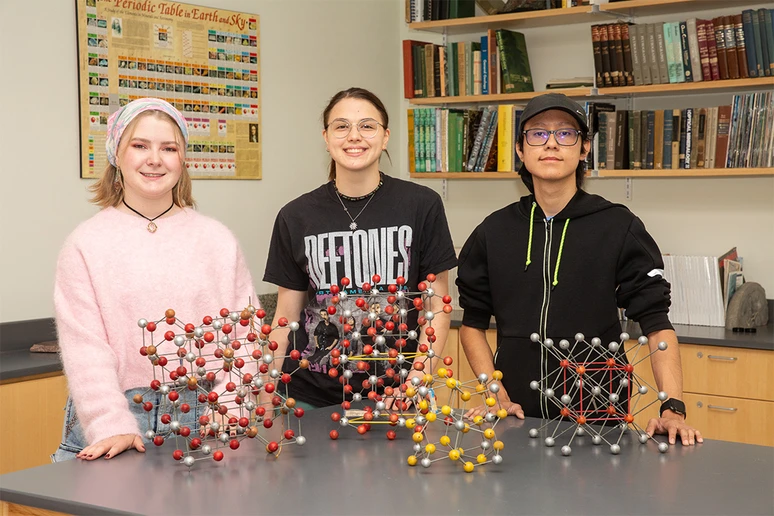

Gathering in a Houghton Hall lab are (from left): Mia Enders, Isabelle “Belle” Price and Nicky Flores.


Gathering in a Houghton Hall lab are (from left): Mia Enders, Isabelle “Belle” Price and Nicky Flores.
SUNY Fredonia science students are sharing findings of geology research compiled this past summer at several professional venues.
For her project, “Revealing Rare Earth Elements (REEs) Enrichment: An Example of a Garnet Amphibolite from southern Brasilia Orogen,” Mia Enders, a senior Geology major with a minor in Chemistry, focused on her research conducted at the Pacific Northwest National Laboratory (PNNL), supported by the U.S. Department of Energy Visiting Faculty Fellowship along with Associate Professor Wentao Cao. She gave an oral presentation on this experience at the September meeting of the Buffalo Association of Professional Geologists (BAPG).
Ms. Enders, of Bath, NY, did research to chemically characterize rare-earth element-bearing minerals in an REEs-enriched specimen, specifically looking for minerals that host these elements. Rare earth elements, a group of 17 chemical elements (lanthanides with scandium and yttrium) on the periodic table, are an essential ingredient in modern technology, medical devices and defense systems. Her PNNL experience provided networking opportunities as well as valuable experience that will be of interest to prospective employers.
“Through my research, I’ve gotten to use a lot more equipment than most students are exposed to. It’s given me hands-on experience that I can take into future work,” she added. Interacting with professionals at all levels in the industry is another bonus of Enders’ research. Non-research students may not have these opportunities.
“I worked with six different instruments at the Pacific Northwest National Laboratory. It’s cool to see all of the different results and how they’re presented, how to analyze them, and I find that really interesting,” Enders explained.
In her oral presentation at the same BAPG meeting, Isabelle (Belle) Price, a senior Biochemistry major from Rochester, NY, discussed the Research Experiences for Undergraduates (REU) in the CorGGLE (Cornell Geopaths Geoscience Learning Ecosystem) program she attended at Cornell University this past summer.
In her oral presentation about that work, “The Effect of Sulphur Hydrous Partial Melting in the Mantle Wedge,” Ms. Price concluded that oxidizing conditions may lead to the generation of greater volumes of melted mantle (magma) beneath volcanoes in subduction zones.
She gained experience utilizing hydraulic presses and high temperature furnaces that are designed to mimic the conditions deep within the Earth — inside of a lab. Work on these questions will lead to a better understanding of conditions and timescales of geologic processes on Earth and other planets.
Tools that she used included a piston-cylinder, which can simultaneously generate high pressure and temperature, and an electron microprobe, a high-powered microscope that uses electrons to examine the chemical composition of a sample.
Enders and Price will also deliver poster presentations on their summer research at GSA Connects 2025, the national meeting of the Geological Society of America, in San Antonio, TX, to be held Oct. 19 to 22. The conference is the largest conference of its kind in North America.
They will be joined by Nicky Flores, a junior Geology major from the Bronx, NY, who will present his research, “Retrieving Metamorphic Conditions of Felsic Granulite from the Western Grenville Province in Canada.”
“The objective of our research is to better our understanding of the origin of the orogenic evolution of the 1.0-billion-year-old Grenville Mountain belt, its conditions and reach and its tectonic evolution,” explained Mr. Flores, who worked together with Associate Professor Wentao Cao. The College of Liberal Arts and Sciences' Bradley Endowment for Undergraduate Research in the Sciences Fellowship, established through Fredonia College Foundation, supported the research project.
The Grenville Province in eastern Canada is the core of a billion-year-old mountain range that has been completely eroded. The rocks there tell a story of the intense pressures and temperatures of mountain building when the mountains are no longer evident at the surface.
“We used the chemistry of various minerals and thermodynamic modeling to help show the pressure and temperature model which can be used to help the tectonic evolution,” he added.
Flores gained experience with two computer software programs: Calcmin, used to calculate a mineral’s chemical composition and percentage, and Perple_X, a program that calculates phase diagrams and models equilibrium phase boundaries for temperature and pressure conditions beneath the Earth’s surface.
“The results found point to diverse pressure conditions across lithologies during Grenville metamorphism, suggesting that it is slightly lower peak pressures but similar or greater temperatures when compared to earlier studies on migmatized metabasites,” Flores said.
The GSA conference provides opportunities for students to share their research with prospective employers and build professional connections.
“This trip will provide me with a fantastic opportunity to network with geoscientists and explore relevant research topics,” Price said. It’s also her first national geology conference. She’s also rooming with Enders, her best friend, and looks forward to sharing thoughts and excitement with her each day.
The conference includes field trips, special lectures, oral sessions, lightning talks and poster sessions. This year’s themes are “Energy and Resource Innovations in the 21st Century,” “Geology Without Borders” and “From Earth to the Cosmos: Geoscience Beyond Our Planet.”
Student attendance at the GSA meeting is funded by the Susan Mara Endowment for Experiential Learning through the Fredonia College Foundation.